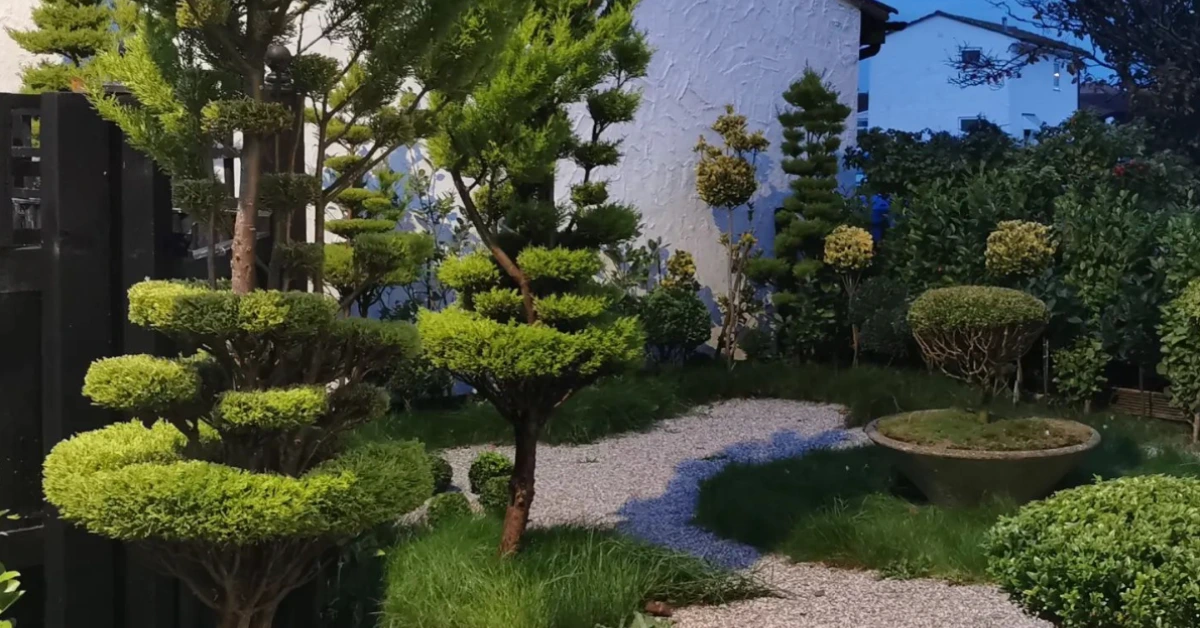Step into the tranquility of your own sacred space, as we unveil the enchanting world of a “Small Meditation Garden.” In a bustling world, where stress often overshadows serenity, this miniature haven offers solace and a profound connection to nature.
Our journey will lead us through the art of compact design and plant choices that harmonize perfectly with these cozy retreats. Whether you’re an urban dweller with limited outdoor space or simply seeking a pocket of serenity, you’ll discover that creating a Small Meditation Garden is not only possible but a delightful endeavor.
Join us as we embark on the adventure of transforming small spaces into powerful sanctuaries of stillness and reflection. Welcome to the world of Small Meditation Gardens, where you can experience big moments of inner peace (Even if you are no gardening person as me 😄).
I love this Yoga mat 🧘🏼♀️
✅ Anti-Slip Surface ✅ Effortless Cleaning
✅ Conscious & Safe Materials
Purpose of Small Meditation Garden
Meditation gardens are outdoor spaces designed to promote relaxation, mindfulness, and inner peace. These gardens provide an oasis of calm in a busy world and offer a space to escape from the stresses of daily life. As someone who enjoys meditation, I have found that a meditation garden can be a valuable tool in my practice.
The purpose of a meditation garden is to create a peaceful environment that encourages mindfulness and introspection. These gardens are typically small and intimate, with carefully chosen plants, seating, and other elements designed to create a calming atmosphere. By providing a quiet, secluded space, a meditation garden can help you focus your thoughts and clear your mind.
Meditation gardens can also have physical health benefits. Spending time in nature has been shown to reduce stress, lower blood pressure, and improve overall well-being. By creating a space that is both calming and beautiful, a meditation garden can help you connect with nature and experience these benefits firsthand.
Designing Your Small Meditation Garden

As I plan my small meditation garden, I find that designing it thoughtfully is key to creating a peaceful and relaxing space. Here are some tips on how to get started.
Choosing the Right Elements
When selecting elements for your meditation garden, keep in mind that the goal is to create a space that promotes relaxation and mindfulness. Here are some elements to consider:
- Plants: Choose plants that are easy to care for and create a calming atmosphere. Some good options include lavender, jasmine, and rosemary.
- Water Features: The sound of water can be incredibly soothing. Consider adding a small fountain or a water bowl to your garden.
- Seating: Choose comfortable seating that allows you to relax and meditate. A simple bench or a cushioned chair can work well.
- Lighting: Soft lighting can help set the mood for meditation. Consider adding string lights or lanterns to your garden.
Creating a Layout
Once you have chosen the elements for your meditation garden, it’s time to create a layout that works for your space. Here are some tips:
- Plan for Privacy: Consider adding a fence, trellis, or tall plants to create a sense of privacy in your garden.
- Create a Focal Point: A focal point can help anchor your garden and create a sense of calm. Consider adding a statue, a birdbath, or a large plant as a focal point.
- Keep it Simple: A cluttered garden can be distracting and overwhelming. Keep your design simple and focus on a few key elements.
- Consider the Seasons: Choose plants and elements that will work well in your climate and that will look good year-round.
By choosing the right elements and creating a thoughtful layout, you can design a meditation garden that promotes relaxation and mindfulness.
Selecting Plants for Small Meditation Garden

When it comes to selecting plants for a meditation garden, it’s important to choose those that promote a sense of calm and relaxation. Here are a few options to consider:
Aromatic Plants
Aromatic plants are a great addition to any meditation garden. They not only add a pleasant fragrance to the space but also have calming properties that can help you relax. Some popular aromatic plants include:
- Lavender: Known for its relaxing properties, lavender is a great choice for a meditation garden. Its soothing scent can help reduce stress and anxiety.
- Rosemary: This fragrant herb is said to help improve memory and focus, making it a great addition to a meditation garden.
- Sage: Another herb with a calming scent, sage is often used in aromatherapy to help reduce stress and anxiety.
Colorful Plants

Colorful plants can also help create a peaceful and relaxing atmosphere in a meditation garden. Here are a few options to consider:
- Pale Purple Coneflower: This prairie icon produces purple or yellow blooms that can add a pop of color to your meditation garden.
- Japanese Maple: With its vibrant red leaves, the Japanese maple is a stunning addition to any garden.
- Blue Star Creeper: This low-growing ground cover produces delicate blue flowers that can add a touch of color to your meditation garden.
When selecting plants for your meditation garden, it’s important to choose those that are easy to care for and suited to your climate. By selecting the right plants, you can create a peaceful and relaxing space that promotes mindfulness and relaxation.
Most Important Elements When Creating Your Own Small Meditation Garden – Checklist

If you have a small outdoor space, you can still create a peaceful and relaxing meditation garden. Here are some tips to get you started:
- Find the perfect spot: Look for a quiet and secluded area in your yard, away from any distractions. This could be a corner of your patio, a small patch of grass, or even a balcony. Make sure it’s a space where you feel comfortable and relaxed.
- Choose the right plants: Select plants that are known for their calming and soothing properties, such as lavender, jasmine, or chamomile. These plants will not only look beautiful but also provide a calming scent to help you relax.
- Add some water features: The sound of flowing water can be incredibly soothing and help you to focus during your meditation practice. Consider adding a small fountain, bird bath, or even a small pond to your meditation garden.
- Create a seating area: You’ll want to have a comfortable place to sit while you meditate, so consider adding a bench, chair, or even some cushions to your garden. Make sure it’s a spot where you can sit comfortably for an extended period of time.
- Incorporate natural elements: Incorporating natural elements such as stones, wood, and other natural materials can help create a sense of calm and tranquility in your garden. Consider adding a small rock garden, a wooden pathway, or even a small fire pit to your meditation garden.
Remember, the most important thing is to create a space that feels peaceful and relaxing to you. With a little planning and creativity, you can transform even the smallest outdoor space into a tranquil meditation garden 🏡.
FAQ
What is a small meditation garden, and how does it differ from larger meditation gardens?
A small meditation garden is a compact and carefully designed outdoor space that encourages mindfulness, relaxation, and self-reflection. While it shares the same principles as larger meditation gardens, it is tailored to fit into smaller spaces and often emphasizes simplicity and minimalism to create a serene environment.
What design elements are typically recommended for small meditation gardens, given limited space?
In small meditation gardens, it’s advisable to focus on key elements like a comfortable sitting area, a water feature (such as a small fountain or birdbath), potted plants or shrubs, and symbolic objects or stones. These elements provide a balanced and peaceful atmosphere in a limited area.
How can individuals make the most of a small meditation garden and optimize its tranquility?
To maximize tranquility in a small meditation garden, it’s essential to keep the space uncluttered and incorporate elements that inspire mindfulness. Consider the flow of energy, maintain simplicity in design, and choose plants and materials that resonate with your personal sense of calm and relaxation.
Are there specific meditation practices or techniques ideal for small meditation gardens?
Small meditation gardens are adaptable to a range of meditation practices, including mindfulness, loving-kindness, and breath awareness. Consider integrating these practices into your small garden routine to enhance your meditation experience, making the most of the serene space.
If you liked this blog article about small meditation garden, don’t forget to follow us on Pinterest so you don’t miss any more meditation news!







